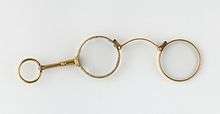Lorgnette
A lorgnette (/lɔːˈnjɛt/) is a pair of spectacles with a handle, used to hold them in place, rather than fitting over the ears or nose. The word lorgnette is derived from the French lorgner, to take a sidelong look at, and Middle French, from lorgne, squinting.[1] They became popularized by Englishman George Adams when he designed a practical case meant to be carried in the pocket.[2]


The lorgnette was usually used as a piece of jewelry, rather than to enhance vision. Fashionable ladies usually preferred them to spectacles. These were very popular at masquerade parties and used often at the opera. They were worn popularly in the 19th century. The lorgnette was employed as a prop and affectation by early 20th century trial lawyer Earl Rogers, and one is featured on the front cover dust jacket of his biography, Final Verdict, by his daughter Adela Rogers St. Johns.[3]
References
| Wikimedia Commons has media related to Lorgnette. |
- "Lorgnette - Definition and More from the Free Merriam-Webster Dictionary". Merriam-webster.com. Retrieved 21 October 2014.
- George Adams; Rosenthal, J. William (May 1994). Spectacles and Other Vision Aids: A History and Guide to Collecting. Norman Publishing, 1994. p. 118. Retrieved 16 October 2018.
- Final Verdict by Adela Rogers St. Johns, 1962, Doubleday & Co.
Template:Lorgnette